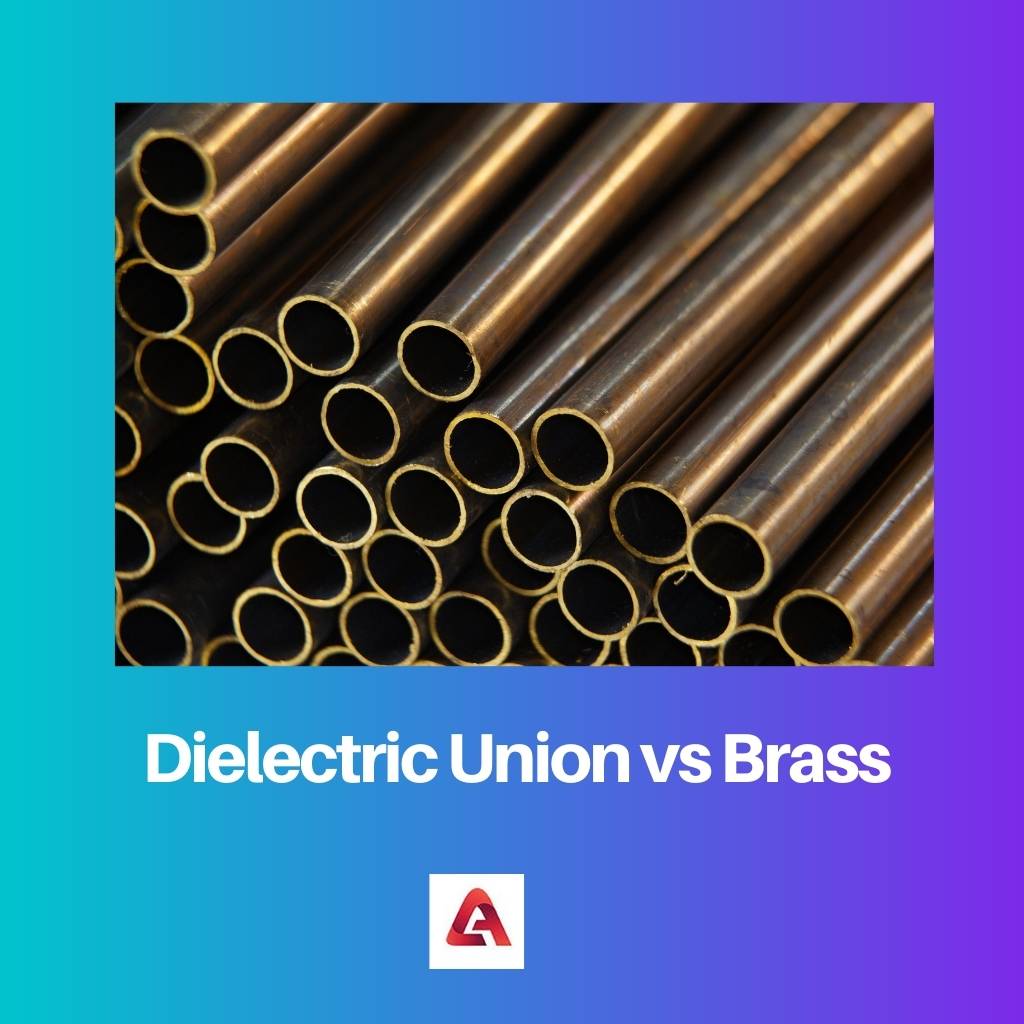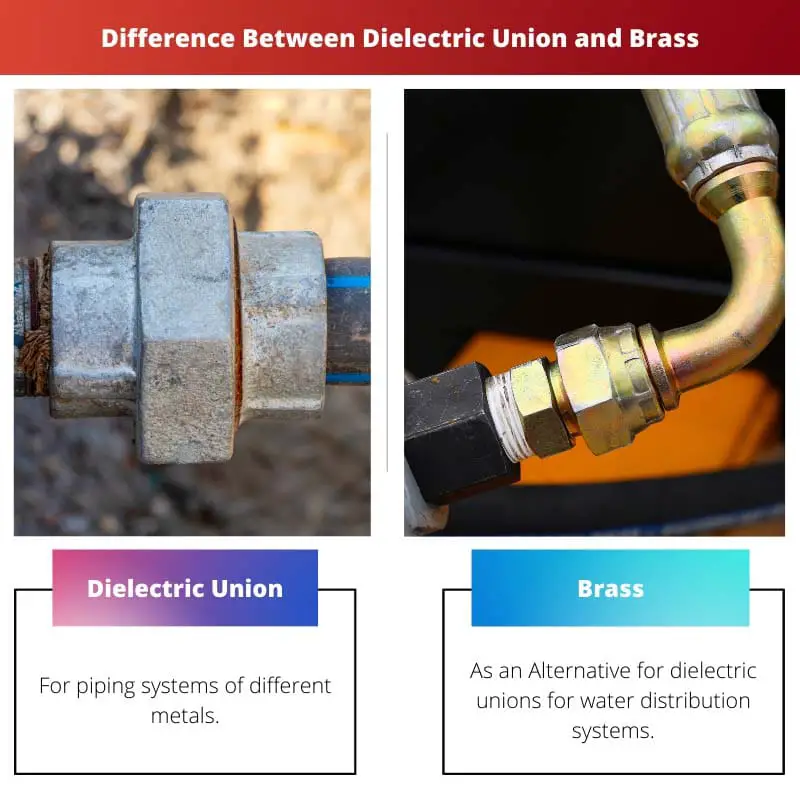There are many devices which are used in the houses. Knowledge of proper use of them should be known as these are required for crucial purposes, such as devices used for tapping into water pipes.
For these purposes, you should be aware of the right tools that can solve the problems, especially when it comes to water and pipe. As sometimes electrolytic reactions can take place, water acts as the electrolyte. This results in metal corroding. And it is called galvanic corrosion.
To prevent this mishappening, a few tools are used. These include Dielectric Union and Brass. While both of them are used for the same purposes, there are many differences among them.
Key Takeaways
- A dielectric union is a plumbing fitting that uses a non-conductive material to prevent galvanic corrosion, while brass fittings are made from copper and zinc alloy.
- Dielectric unions are used to join pipes of different metals to prevent corrosion, while brass fittings are commonly used in various plumbing applications.
- Dielectric unions can be more expensive than brass fittings, but they provide a higher level of protection against corrosion and can extend the plumbing system’s lifespan.
Dielectric Union vs Brass
Dielectric union is installed between pipes made from dissimilar metal that provides a break in electrical conductivity and prevents accelerated corrosion and deterioration in the piping system. Brass is an alloy of copper and zinc and is used as a type of copper alloy fitting.

Dielectric Union is used to connect the two different types of metals; it can be for repairing the piping system or for any other purpose. It is mostly used for the water distribution system of commercial and residential areas and is made up of brass or galvanized steel.
Brass is the best alternative for a dielectric union for water distribution system problems. It is used where water is not of great quality, as it is the area where most corrosion takes place, as dielectric will not work with the corrosion. It is made up of an alloy of copper and zinc.
Comparison Table
| Parameters of Comparison | Dielectric Union | Brass |
|---|---|---|
| Used | For piping systems of different metals | As an Alternative for dielectric unions for water distribution systems |
| Applications | Commercial and residential water distribution systems | Repair industry |
| Made up of | Galvanized steel and lead-free brass | An Alloy of copper and zinc |
| Preferred for | Fittings in the water distribution systems. | Where water quality is poor. |
| Affordable | More affordable | Less affordable |
What is Dielectric Union?
It is a type of fitting used for the piping system where you have to connect two different metal pipes. It helps prevent any kind of leakage that can lead to big and crucial problems.
It helps prevent the galvanic corrosion that can take place due to corrosion that takes place due to the presence of two different types of metallic pipes.
Electrolysis and deterioration mostly take place in commercial and residential areas, and that is the reason it is mostly used in this area, as the plastic composite of the union’s clamping helps break the electrical continuity in the water distribution system.
A dielectric union has non-conductive fibre in its sleeve. That fibre surrounds the brass of the fitting. It was mainly made to use copper.
The voltage involved in galvanic electrolysis is not harmful. It is used and preferred by many people as it is suitable for most conditions, and it is quite inexpensive for the purpose it serves.
This tool is required in every household, for example, for watering when a person has to join to pipes (especially pipes from different metals) if he is not careful enough, a huge blunder can take place.
What is Brass?
We are very familiar with the Dielectric Union, how it works and for what purpose it is required. For the places where a Dielectric Union cannot be used, Brass is the best alternative.
For example, earlier, it was discussed ho Dielectric Union was used for household pipes where water is of good quality, but what about the areas where the quality of water is not good? There Brass is used for the same purpose as the Dielectric.
It is approved for working under the water in the water distribution system and is the best where galvanised materials are found to have a high chance of corrosion.
Brass is made of copper and zinc malleable alloys and is not new in the market. It has been used for many years. As the Dielectric Union created problems in the repair industry, it was replaced with brass.
IPS and NPT standards are used to manufacture the brass fittings and are very compatible with copper, PEX, PE, and ipe or tubing.
It has a disadvantage that brass is very vulnerable to acidic water. Therefore it cannot be used anywhere near acidic water. Although it is expensive, for the benefits and high quality it provides, it is worth every cent.

Main Differences Between Dielectric Union and Brass
- Dielectric Union and Brass are used for slightly different purposes. Dielectric Union is the best choice for connecting two different or dissimilar, or even similar, pipes, while brass is used as an alternative for water distribution systems.
- Applications for both of them are also different. Dielectric Union is the option for commercial and residential purposes of water distribution, and for the industry where repair for some piping-related work is done, Brass is the option.
- Dielectric Union is made of galvanized steel, or even lead-free, and is used in the making process and brass in the alloy of copper and zinc both.
- Another difference between them is the presence of an elastomeric rubber gasket, which is present in the Dielectric Union but is absent in Brass.
- Dielectric Union is mostly preferred for the fitting work in the water distribution system, while brass is the ideal choice for poor quality water where the chance of corrosion is high.
- Brass is more expensive in comparison. Therefore, it is less affordable. On the other hand, Dielectric Union is a much affordable option.

- https://ieeexplore.ieee.org/abstract/document/884022/
- https://www.sciencedirect.com/science/article/pii/S0010938X67800908
- https://meridian.allenpress.com/rct/article-abstract/52/3/605/91081

What a detailed article! The comparison table makes it easier to understand the differences between dielectric union and brass
Agreed
The article details the applications and uses of these materials, this is very comprehensive
Absolutely
Yes, and it’s well structured
The detailed explanation of dielectric union and brass is very engaging. There is so much to learn from this article
I’ve learned a lot about the differences between dielectric union and brass. The comparison table helps to understand which one is suitable for different purposes
Yes, this is highly informative
An enlightening read. The details about the materials and their uses is impressive
This is very informative
Definitely, it’s an excellent source of information
The purpose and use of dielectric union and brass are clearly explained. This is a very helpful article
Absolutely, it’s a great resource
A highly informative read, it’s important to know about dielectric union and brass
It’s important to know the composition and application of these materials for the plumbing system. The voltage involved in galvanic electrolysis is quite enlightening
I absolutely agree
Absolutely informative. We use dielectric unions in commercial and residential areas, and understanding its composition and function is crucial
Definitely, it’s a valuable insight
The article definitely provides detailed information
This article provides a clear understanding of the different uses and suitability of dielectric union and brass
Absolutely, and it’s a valuable reference